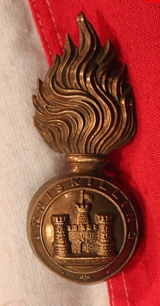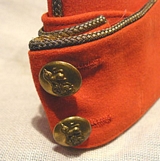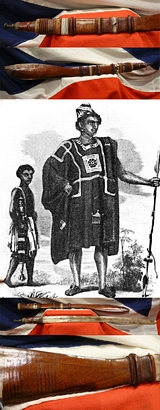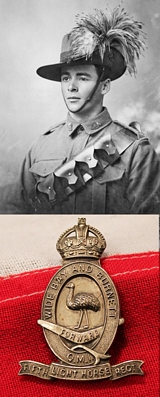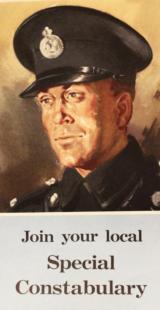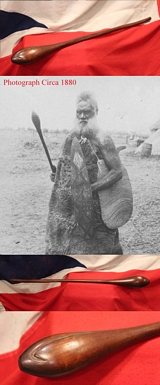A Victorian 1881 Inniskilling Fusiliers Busby Helmet Grenade
In October 1899 war broke out between the United Kingdom and the Boer Republics. The 1st Battalion landed at Durban, where they became part of the 5th (Irish) Brigade. The battalion was involved in a series of military reverses at the hands of the Boers that became known as the "Black Week", culminating in defeat at the Battle of Colenso. The unit subsequently took part in the Tugela Campaign before helping relieve Ladysmith in early 1900. The regiment lent its name to "Inniskilling Hill", which was taken by the 5th brigade on 24/25 February 1900. In 1914 the Great War broke out and the 2nd Battalion was first to see action in the Battle of Le Cateau. The 1st Battalion participated in the Landing at Cape Helles on the Gallipoli peninsula in April 1915 with the 29th Division. There were also nine New Army battalions raised seeing service with the 10th (Irish) Division, the 16th (Irish) Division and the 36th (Ulster) Division on the Western Front and at Gallipoli, the Macedonian Campaign and Palestine. read more
85.00 GBP
Meissen Porcelain Round The World Zeppelin Flight Medal
1929 GERMANY. 1929 Graf Zeppelin World Flight Medal. Red Porcelain, 50.7mm. Near mint condition.
Obv. Airship over Eastern
Hemisphere globe, GRAF ZEPPELIN WELT
RUNDFLUG . Rev. Airship over Western Hemisphere globe, FRIEDRICHSHAFEN. TOKIO. LOS ANGELES. LAKEHURST . A classic Zeppelin
issue made by the State Porcelain Factory of Meissen, mintmark crossed swords, Kurschwertern . MEISSEN TABLE MEDAL - GRAF ZEPPELIN "AROUND THE WORLD VOYAGE" - 1929. Meissen was one of the premier makers of tableware and porcelain items in Imperial Germany. The firm is hundreds of years old, and has survived to this day. A large-format table medal that salutes the Graf Zeppelin?s (LZ-127) "Around the World Tour." The tour began in Friedrichshafen, Germany, where the Graf Zeppelin was built, and continued on to Tokyo, Los Angeles, and Lakehurst, NJ (where her sister ship, the Hindenburg, exploded in May 1937) before returning to Germany. It measures 2" in diameter and is chocolate brown. It shows hallmarking for Meissen on both sides.In 1929, the Graf Zeppelin, LZ-127, made a world flight, stopping at Friedrichshafen, Tokyo, and Los Angeles. Although the Graf was not the first aircraft to circle the globe, it took only 21 days, 7 hours, 34 minutes, a new record for round-the-world travel by any means. Furthermore, it carried a full passenger load over much previously uncharted land. read more
235.00 GBP
A South American Sorocabana Knife 'Faca De Ponta’ of the South American Cowboys
"Sorocabana knife". It was the knife used by the bandeirantes of Sao Paulo and by the tropeiros who traveled between the south and southeast regions. Made from an imported blade from Gebruder Weyersberg Solingen. Gilt decorated makers panel. Carved ebony hilt In the southern region of Brazil , "tropeiro" was the conductor of mules troops from the city of Viamao, Rio Grande do Sul, to Sorocaba, Sao Paulo. These troops supplied the gold cycle in Minas Gerais in the eighteenth century. This activity was responsible for the founding of countless cities in the states of Rio Grande do Sul, Santa Catarina and Parana. Before the railways, and long before the trucks, merchandise trade was done by drovers in regions where there were no alternatives for sea or river navigation for distribution.
The interior regions, far from the coast, depended for a long time on this mode of transportation by mules . Since the end of the seventeenth century, mining works, for example, required the formation of groups of merchants in the domestic trade. Initially called men of the way, traffickers or passers-by, the tropeiros became fundamental in the trade of slaves , food and tools of the miners.
Far from being specialized merchants, the tropeiros bought and sold of everything a little: slaves, tools, clothes, etc. The existence of Tropeirismo was intimately related to the coming and going of roads and highways, especially the Estrada Real - road through which Minas Gerais gold arrived at the port of Rio de Janeiro and followed to Portugal . read more
285.00 GBP
An Edwardian Colonel's Scarlet Cloth Sidecap, of 15th The Kings Hussars. With Gold Bullion Trim.
Good condition overall. With two Lion and Crown buttons for the rank of Colonel and Brigadier, used in WW1.
In the First World War, they landed at Rouen in France on 18 August 1914: the squadrons were attached to different infantry divisions to form the divisional reconnaissance element: A Squadron was attached to 3rd Division, B Squadron was attached to 2nd Division and C Squadron was attached to 1st Division. On 14 April 1915, the squadrons returned to regimental control and the regiment was placed under the command of the 9th Cavalry Brigade in the 1st Cavalry Division. The regiment remained on the Western Front throughout the war. It participated in most of the major actions where cavalry were used as a mounted mobile force. They were also used as dismounted troops and served effectively as infantry. On 11 November 1918, orders were received that the 1st Cavalry Division would lead the advance of the Second Army into Germany, by 6 December 1918, having passed through Namur, the division secured the Rhine bridgehead at Cologne.
The regiments battle honours in the Great War: Mons, Retreat from Mons, Marne 1914, Aisne 1914, Ypres 1914 '15, Langemarck 1914, Gheluvelt, Nonne Bosschen, Frezenberg, Bellewaarde, Somme 1916 '18, Flers-Courcelette, Cambrai 1917 '18, St. Quentin, Rosières, Amiens, Albert 1918, Bapaume 1918, Hindenburg Line, St. Quentin Canal, Beaurevoir, Pursuit to Mons, France and Flanders 1914-18
One of the famed of the regiment, Louis Nolan, was an officer of the 15th Hussars who gained notoriety as the bearer of the ill-fated order precipitating the Charge of the Light Brigade.
Around 30 years ago we were honoured to have acquired the undress sabretache of Captain Nolan of the 15th that carried the order in the ‘Charge’. It was recovered from beneath his slain body and steed, and was previously on loan for display in two museums, including Alexandra Palace, for over 100 years after its return to the family. read more
160.00 GBP
Antique Mandingo Chieftain's Slave and Gold Trader Sword With Tattoo'd Leather Scabbard
A chieftain's weapon of Mandingo slave and gold traders. The Manding (Mandingo) are West African people. Their traditional sword for the slave traders comprises a sabre like blade, guardless leather grip and scabbard with exquisite leather work. This example is a long sized example, of a high ranking Mandingo, of very nice quality and finely tattooed. 25 inches long curved blade, leather grip and leather scabbard with leaf shaped widening tip, entirely tooled tattooed and decorated. Of special interest is the finely bound and decorated leather work. These weapons are well known for their leather-work and the tattooing applied to the leather of the scabbards. The iron work skills are less well developed. Many blades are taken from European weapons such as sabres and cutlasses.
While the Baule are a distinct tribal group to the west, it is important to observe that Malinke is a variant term applied to the Mandingo (also Manding, Mandin, Mande).
In general, these remain primarily considered Mandingo weapons, and from regions in Mali. These were of course invariably mounted with European sabre blades. Mandingo Tribe (also known as the Mandinka, Mande, or the Malinke Tribes) were the traders of the African West Coast, trading primarily in gold and slaves from other African tribes. The blades comes out a little from the chape. Small areas of leather separation on the scabbard binding. Picture in the gallery of an 1850's engraving of a Mandingo Chief and his sword bearer. read more
395.00 GBP
An Antique 18th Century Indian Armour Piercing Punch Dagger Katar, Combat Damaged, or Adapted For Armour Wear
The Katar is an amazing combat weapon from the Indian sub continent, in combat use by select warriors and nobles for five centuries, it is a scarcely seen piece, yet highly distinctive and iconic. It was designed in several forms, some long and relatively light, others extremely robust and overtly powerful. This is one of the latter types. It’s ‘crow’s beak’ penetrating tip shows and strongest possible ribbed blade design was so efficient that effectively there was likely no body armour that could not be penetrated by such a powerful piece, once in the hands of a Katar wielding expert. It has been forged in great and powerful quality, and is a very high quality example with superior heft.
One of the bracing arms has been lost, very possibly from an opponents sword cut, although we have seen this before and we were informed by an esteemed elderly Indian warfare scholar that it has been known for one arm to ge removed so an an armoured warrior could use a the Katar while wearing the right fore-arm protector combat armour, known as the the bazu band. While wearing the bazu band armour the warriors forearm is much wider than usual and a Katar’s narrow arm extensions would preclude its use in combat while wearing armour.
The katar originated in Tamil Nadu where its Dravidian name was kattari before being altered to katar in the north. The earliest forms occur in the medieval Deccan kingdom of Vijayanagara. Katar dating back to this period often had a leaf- or shell-like knuckle-guard to protect the back of the hand, but this was discarded by the latter half of the 17th century. The Maratha gauntlet sword or pata is thought to have been developed from the katar. As the weapon spread throughout India it became something of a status symbol, much like the Southeast Asian kris or the Japanese katana. Among the Rajputs, Sikhs and Mughals, princes and nobles were often portrayed wearing a katara at their side. This was not only a precaution for self-defense, but it was also meant to show their wealth and position. Upper-class Mughals would even hunt tigers with katar. For a hunter to kill a tiger with such a short-range weapon was considered the surest sign of bravery and martial skill. The heat and moisture of India's climate made steel an unsuitable material for a dagger sheath, so they were covered in fabric such as velvet or silk. Because the katara's blade is in line with the user's arm, the basic attack is a direct thrust identical to a punch, although it could also be used for slashing. This design allows the fighter to put their whole weight into a thrust. Typical targets include the head and upper body, similar to boxing. The sides of the handle could be used for blocking but it otherwise has little defensive capability. As such, the wielder must be agile enough to dodge the opponent's attacks and strike quickly, made possible because of the weapon's light weight and small size compared to a long sword. Indian martial arts in general make extensive use of agility and acrobatic maneuvers. As far back as the 16th century, there was at least one fighting style which focused on fighting with a pair of katara, one in each hand. read more
345.00 GBP
A Superb Silver Australian 5th Light Horse Mobile Infantry Badge
Excellent rare and original example [Wide Bay and Burnett Light Horse] Queensland Mobile Infantry. The history of the 5th Light Horse is distinguished and goes thus; The 5th Light Horse Regiment was raised in Brisbane in September 1914, entirely from men who had enlisted in Queensland, and became part of the 2nd Light Horse Brigade. Sailing from Sydney on 21 December 1914, the regiment disembarked in Egypt on 1 February 1915.
The light horse were considered unsuitable for the initial operations at Gallipoli, but were subsequently deployed without their horses to reinforce the infantry. The 2nd Light Horse Brigade landed in late May 1915 and was attached to the 1st Australian Division. The 5th Light Horse played a defensive role for most of the campaign but was involved in several minor attacks. It left the peninsula on 20 December 1915.
Back in Egypt, the 2nd Light Horse Brigade became part of the ANZAC Mounted Division and in February 1916 joined the forces defending the Suez Canal from a Turkish advance across the Sinai Desert. The 5th Light Horse?s main activity in the Sinai was long-range patrolling, but it was involved in several small engagements during August, as the Turks retreated after their defeat at Romani.
The ANZAC Mounted Division advanced into Palestine in late December 1916. The 5th?s work predominantly continued to be patrols and raids until the advance stalled before the Turkish bastion of Gaza. The regiment participated in all three battles aimed at capturing the town, most notably the first abortive attempt on 27 March 1917. On this occasion the 5th attacked Gaza from the rear and was fighting its way through streets and gardens when ordered to withdraw.
With the fall of Gaza on 7 November 1917, the Turkish position in southern Palestine collapsed. The 5th was involved in the pursuit that followed, and then spent much of the first half of 1918 holding the west bank of the Jordan River. During this time it was involved in the Amman (24?27 February) and Es Salt (30 April?4 May) raids, both of which were tactical failures but helped to convince the Turks that the next offensive would be launched across the Jordan.
Instead, the offensive was launched along the coast in September 1918, with the 5th taking part in a subsidiary effort east of the Jordan. It attacked at Amman on 25 September, and on 29 September 4,500 Turks surrendered to just two squadrons from the regiment at Ziza. Turkey surrendered on 31 October 1918, but the 5th Light Horse was employed one last time to assist in putting down the Egyptian revolt of early 1919. It sailed for home on 28 June 1919. Text from AWM
One of the most famous men of the 5th Light Horse was sniper Trooper Sing at Gallipoli. Trooper Sing sniped from a position known as Chatham's Post, his tally stated as 150 confirmed, but a higher informal estimate puts his tally at 201. The discrepancy can be accounted for by the way such hits were recorded. On 23 October 1915, General Birdwood issued an order containing his compliments on Trooper Billy Sing's performance accounting for the 201 Turks. Private Sing was awarded the Belgian Croix de Guerre in early 1918, probably for his role in leading a patrol eliminating some German snipers at Polygon Wood in September 1917. Studio portrait in the gallery is of 1707 Lance Corporal (L Cpl) John James Marsh, 5th Light Horse Regiment from Murraria, Queensland. A 21 year old grocer prior to enlisting on 18 August 1915, he embarked for overseas with the 11th Reinforcements from Sydney on 21 October 1915 aboard HMAT Hawkes Bay. He served with the regiment in the Middle East where he was wounded in action at Gaza and died on 6 November 1917. L Cpl Marsh is buried in the Beersheba War Cemetery, Israel. Original badge, pattern1930/42, with two lug fixing in superb order and superb quality definition. read more
295.00 GBP
A 1200’s Old Knight's Prick Spur, Still With Buckle From The IInd Baron’s War of Henry IIIrd and Earl Simon de Montfort
We show a medeavil drawing from the British Museum of a kneeling knight wearing the very same form of prick spur. It is absolutely remarkable that this spur stil has its leather strap buckle and mount in place. Battle of Lewes period, from the IInd Baron’s War
The Battle of Lewes was one of two main battles of the conflict known as the Second Barons' War. It took place at Lewes in Sussex, on 14 May 1264.[1] It marked the high point of the career of Simon de Montfort, 6th Earl of Leicester, and made him the "uncrowned King of England". Henry III left the safety of Lewes Castle and St. Pancras Priory to engage the barons in battle and was initially successful, his son Prince Edward routing part of the baronial army with a cavalry charge. However, Edward pursued his quarry off the battlefield and left Henry's men exposed. Henry was forced to launch an infantry attack up Offham Hill where he was defeated by the barons' men defending the hilltop. The royalists fled back to the castle and priory and the King was forced to sign the Mise of Lewes, ceding many of his powers to Montfort.
The battle site is still not completely agreed upon, but part of the conflict was recorded at Offham hill, and this is was just 4 miles south of our farm, Thousands of the protagonists soldiers were supposedly camped within our old grounds, but at present it is not certain for which side they fought. Our farm was originally part of Earl Godwin’s estate, later more famously known as King Harold, who also supposedly camped here before his Battle of Hastings in 1066. A Canadian funded documentary is being filmed here at the current time.
Simon de Montfort, 6th Earl of Leicester (c. 1208 – 4 August 1265), later sometimes referred to as Simon de Montfort to distinguish him from his namesake relatives, was a nobleman of French origin and a member of the English peerage, who led the baronial opposition to the rule of King Henry III of England, culminating in the Second Barons' War. Following his initial victories over royal forces, he became de facto ruler of the country, and played a major role in the constitutional development of England.
During his rule, Montfort called two famous parliaments: the Oxford Parliament stripped Henry of his unlimited authority, while the second included ordinary citizens from the towns. For this reason, Montfort is regarded today as one of the progenitors of modern parliamentary democracy, however during his time as Earl of Leicester he was also determinedly anti semitic and expelled all of the Jews from that city, yet curiously, Leicester's Jews were allowed to move to the eastern suburbs, which were controlled by Montfort's great-aunt Margaret, Countess of Winchester. But as he became ruler of England he also cancelled debts owed to Jews through violent seizures of records. Montfort's party massacred the Jews of London, Worcester and Derby, killing scores of Jews from Winchester to Lincoln. After a rule of just over a year, Montfort was killed by forces loyal to the king in the Battle of Evesham
de Montfort also had connections to the Albigensian Crusade, which was a crusade against the heretic Cathars, and was immensely popular in northern France because it gave pious warriors an opportunity to win a Crusade indulgence. The Albigensian Crusade, Crusade (1209-29) was called by Pope Innocent III against the Cathari, a dualist religious movement in southern France that the Roman Catholic Church had branded heretical. The war pitted the nobility of staunchly Catholic northern France against that of the south, where the Cathari were tolerated and even enjoyed the support of the nobles. Although the Crusade did not eliminate Catharism, it eventually enabled the French king to establish his authority over the south. During the first season the Crusaders captured Boziers in the heart of Cathar territory and following the instructions of the papal legate who allegedly said, Kill them all. God will know his own, when asked how the Crusaders should distinguish the heretics from true Christians massacred almost the entire population of the city. With the exception of Carcassonne, which held out for a few months, much of the territory of the Albigeois surrendered to the Crusaders. Command of the Crusade was then given to Simon, lord of Montfort and earl of Leicester, who had served during the Fourth Crusade. A man, one can safely say was famed for his deeply held religious prejudices, yet ironically, an exponent of parliamentary democracy. read more
475.00 GBP
An Original WW2 British Special Constabulary Recruitment Poster
Published for HMG by Fosh and Cross Ltd London. A propaganda information and recruitment poster. The size as were used in the underground trains advertising panels, or the back of black cabs. Britain re-created the World War I Ministry of Information for the duration of World War II to generate propaganda to influence the population towards support for the war effort. A wide range of media was employed aimed at local and overseas audiences. Traditional forms such as newspapers and posters were joined by new media including cinema (film), newsreels and radio. A wide range of themes were addressed, fostering hostility to the enemy, support for allies, and specific pro war projects such as conserving metal and growing vegetables. In 1940 in particular, Winston Churchill made many calls for the British to fight on, and for British units to fight until they died rather than submit. His calls for fight to victory inspired a hardening of public opinion. Determination raised the numbers of the Home Guard and inspired a willingness to fight to the last ditch, in a manner rather similar to Japanese determination, and the slogan "You can always take one with you" was used in the grimmest times of the war. British victories were announced to the public for morale purposes, and broadcast to Germany for purposes of undermining morale.
Even during Dunkirk, an optimistic spin was put on how the soldiers were eager to return.
When the U-boat commander Gunther Prien vanished with his submarine U-47, Churchill personally informed the House of Commons, and radio broadcasts to Germany asked, "Where is Prien?" until Germany was forced to acknowledge his loss.
The turn of the war made BBC's war commentaries much more stirring.
We never normally comment on the investment potential of any collectable, but the potential for all underpriced WW1 and WW2 posters must be incredible, for example the more famed poster, 'Keep Calm and Carry On' can now sell for over £20,000.
Good condition 14.75 inches x 9.75 inches read more
295.00 GBP
A Most Scarce Antique Australian Aboriginal Throwing Club, Carved Head
Nulla Nulla, Aboriginal, short, possibly mulga wood, very dense hardwood, throwing club with ovoid shaped head, used for hunting, fighting and ceremonial purposes, [South East] Australia, 1860. A waddy, nulla nulla or hunting stick is an Aboriginal Australian club for use in hunting and fighting. The first of these names comes from the Dharuk Aborigines of Port Jackson, Sydney.
A waddy is a heavy, pointed club constructed of carved timber. Waddies have been used in hand-to-hand combat, and were capable of splitting a shield, and killing or stunning prey. In addition to this they could be employed as a projectile as well as used to make fire and make ochre. They found further use in punishing those who broke Aboriginal law, which often involved settling a conflict between individuals, or between an individual and a group, in a 'Trial by Ordeal' in which fighters gave and suffered heavy blows resulting in skull and bone fractures and much blood read more
375.00 GBP


